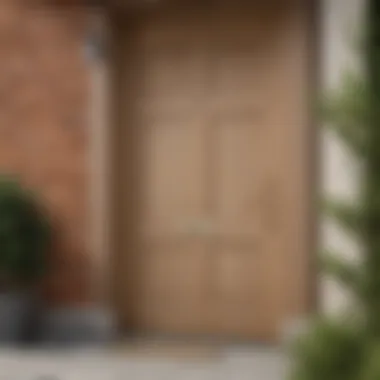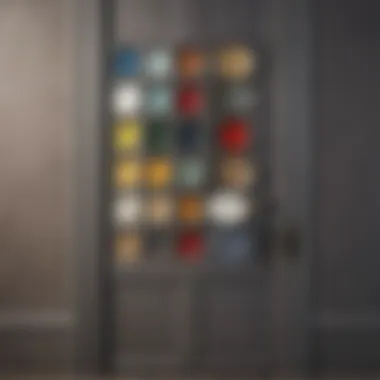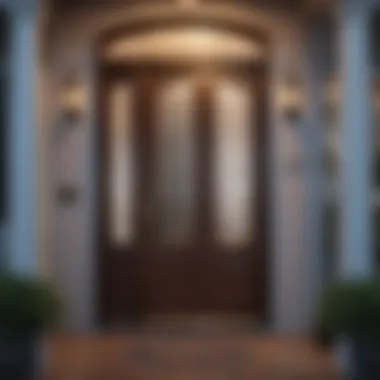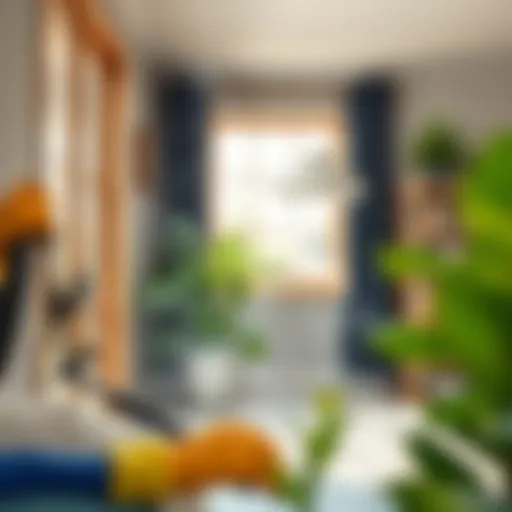Sanding and Painting Your Front Door: A Comprehensive Guide


Intro
Sanding and painting your front door is not just about aesthetics; it represents an important aspect of home maintenance. The front door is often the first thing guests notice, making its appearance significant in conveying your home's personality. Whether you are looking to refresh an outdated look or extend the life of the wood, knowing the right techniques and materials is key.
This guide aims to dissect the entire process into manageable segments, assisting homeowners and DIY enthusiasts alike. From preparation and tools to finishing touches, each aspect has relevance and impact on the outcome.
Design Inspirations
In the realm of design, your front door serves as a canvas for expression. The choices you make can align with contemporary trends or classic styles. This section will explore both aspects to inspire your project.
Trending Styles
Several designs have gained traction in recent years. Here are a few:
- Modern Minimalism: Clean lines and a monochromatic palette create an understated sophistication.
- Traditional Charm: Classic colors like deep red or navy blue paired with ornate hardware can evoke nostalgia.
- Bold Statements: Using vibrant hues such as citrus yellow or emerald green can energize the home’s facade.
Adopting a style often depends on the existing architecture. Ensure that the new design complements the overall look of your residence.
Color Palettes
Choosing the right color for your door can significantly influence the curb appeal. Below are popular palettes:
- Neutral Shades: Whites, grays, and taupes offer timeless elegance and blend well with various styles.
- Nature-Inspired Tones: Earthy greens and browns resonate with natural landscapes and promote tranquility.
- Bright and Inviting: Colors like coral, teal, or sunflower yellow can add zest and charm.
It is worth considering the psychological impact of colors. For instance, blues often convey calmness, while yellows tend to evoke happiness.
"The front door sets the tone for the entire home; choose wisely for your message."
Maintenance and Upkeep
Once the door has been transformed, regular maintenance becomes essential for its longevity and appearance.
Seasonal Maintenance Checklist
A seasonal checklist can help in preserving the door:
- Inspect for Damage: Look for cracks or peeling paint every few months.
- Weatherproofing: Ensure seals are intact, especially before winter.
- Repainting: Consider repainting every 4 to 7 years depending on wear and climate.
Cleaning and Organization Tips
Keeping your front door clean not only enhances its appearance but also checks for any early signs of wear. Here are some tips:
- Use a soft cloth and mild soap for regular cleaning.
- Avoid harsh chemicals that could damage paint or finish.
- Organize any decor around the door seasonally to keep it fresh.
Maintaining a clear and well-kept front door area also enhances the overall appeal of your home. It invites visitors and expresses a sense of care.
In summary, sanding and painting your front door involves not just the act of painting but the considerations leading up to it and the maintenance that follows. Embrace the opportunity to reflect your style while ensuring functionality through informed choices.
Prolusion to Front Door Refinishing
Refinishing your front door is an essential process that can significantly enhance the aesthetic appeal of your home. The front door is not only a functional entry point but also plays a crucial role in setting the tone for your entire entryway. A well-maintained door creates a positive first impression for visitors and can increase your property value.
Importance of Front Door Maintenance
Maintaining your front door is about more than just appearance. Over time, exposure to the elements can cause wear and tear. Rain, sun, and changing temperatures can lead to discoloration and surface damage. Regular maintenance helps protect the door from these damaging factors.
Refinishing your door not only rejuvenates its look but also extends its lifespan. For materials like wood, sanding and painting can prevent rot and termites. For metal doors, proper care can guard against rust. Investing time and effort into front door maintenance reflects a homeowner's dedication to their property as well as adds to the overall curb appeal.
Overview of Sanding and Painting Process
The process of sanding and painting a front door involves multiple steps that require attention to detail. Initially, proper preparation is crucial. This includes removing hardware, cleaning the surface, and assessing any damage that needs fixing. After preparation, the actual sanding begins, where the old finish is removed to create a smooth base for the new paint.


Once the door is sanded, applying a suitable primer is essential before applying the paint. The type of paint chosen can influence durability and appearance, so careful selection is required. Throughout this process, professionals and enthusiasts alike should focus on achieving even application and smooth results to ensure the door looks professionally finished.
"A freshly painted front door can elevate the overall look of your home while providing necessary protection."
In summary, understanding the nuances of refinishing your front door not only encourages creativity in design but also promotes a sense of ownership and pride in your home.
Essential Tools and Materials
When embarking on the journey of sanding and painting your front door, having the right tools and materials is essential. Using appropriate equipment not only streamlines the process but also enhances the final appearance of your work. Quality tools contribute to a smoother application, improving adherence and durability of the paint, as well as reducing the chance of errors during the process. In addition to tools, selecting the correct materials ensures longevity and aesthetic appeal, which are crucial for the front door, often a focal point of a home.
List of Tools Needed
A well-considered selection of tools can make a significant difference. Below is a list of essential tools you will need:
- Sandpaper in multiple grits: Fine, medium, and coarse grades. This variation allows you to prepare the door surface effectively, removing old paint and smoothing imperfections.
- Orbital Sander: This power tool can save time during sanding. It is particularly useful for large flat surfaces.
- Hand sanding block: Useful for hard-to-reach areas where a power sander may not fit well.
- Paintbrushes and rollers: Different sizes will help apply primer and paint smoothly and evenly.
- Drop cloths: Protect surrounding areas from paint splatters and dust.
- Masking tape: Essential for clean lines along edges or where the door meets other surfaces.
- Cleaning cloths: For dusting off all surfaces prior to painting.
Selecting Appropriate Paints
Choosing the right paint is paramount for achieving a successful finish. You must consider both the type of paint and its finish:
- Type of Paint: Look for exterior-grade paint, preferably 100% acrylic, which provides durability against weather elements.
- Finish: Paints come in varying sheens, from matte to high gloss. Glossy finishes tend to withstand wear better and are easier to clean, making them popular choices for doors.
In addition, some paints provide better UV resistance, preventing fading over time. Check the labels or consult reputable sources for guidance, ensuring the selected paint aligns with your aesthetic desires and performance needs.
The right tools and paints are the foundations for a long-lasting, beautiful front door. Investing time in careful selection pays off in the long run.
Preparing the Door for Sanding
Preparing the door for sanding is a critical step in the refinishing process. Skipping this phase or not executing it properly can lead to suboptimal results, making the next steps more challenging. Proper preparation ensures that the newly painted surface adheres well, looks professional, and lasts longer. It involves removing any obstacles, cleaning the surface, and assessing any damage that needs attention.
Removing Hardware and Accessories
Before any sanding occurs, it is essential to remove hardware and accessories from the front door. This includes items such as doorknobs, handles, hinges, and locks. By removing these elements, you avoid damaging them during the sanding process. It also makes it easier to access the entire surface of the door, leading to a more meticulous finish.
Use a screwdriver to detach these components carefully. Keep track of screws and small parts by placing them in a labeled container. This approach will save time when you need to reinstall everything later. Ensuring that the door is completely bare helps the sanding process by allowing you to work on a smooth, uninterrupted surface.
Cleaning the Surface
Once all components are removed, the next step is cleaning the door's surface. This action is crucial as it eliminates any dirt, oils, or debris that could interfere with sanding and painting. Start by wiping down the door with a damp cloth to capture surface grime. After that, using a mild soap solution can help scrub away more stubborn residues.
Make sure to dry the door thoroughly after cleaning. Any moisture remaining can affect the sanding process and the paint adhesion. A clean and dry surface is vital for achieving a smooth finish. Pay attention to crevices and edges where dirt can accumulate. A thorough cleaning ensures that when you begin sanding, you are working with the cleanest slate possible.
Identifying Damage and Repairs
During the preparation phase, it is important to inspect the door for any signs of damage. Look for scratches, dents, or cracks that may have developed over time. Identifying these issues early allows for necessary repairs. Small dings can often be sanded down, but deeper imperfections may require filling with wood filler or putty.
If you notice any water damage or rot, it is essential to address these problems thoroughly. Simple sanding may not suffice if the door has significant structural issues. Repairing these damages will not only affect how the door looks but will also enhance its durability and longevity. A well-prepared door is the foundation of a successful sanding and painting project, and taking time to identify and repair damages will lead to more satisfying results.
Proper preparation ensures that sanding yields an even surface and that painting adheres properly, ultimately saving time and enhancing the door's appearance.
By focusing on these key areas in the preparation stage, homeowners can help facilitate a more efficient and successful refinishing process.
Sanding Techniques
Sanding is a critical component in the process of refinishing your front door. The surface of the door must be properly prepared to ensure that paint adheres well and to create a smooth finish. Poor sanding can lead to uneven surfaces, which will affect the overall appearance of the door once painted. Proper emphasis on sanding techniques can enhance the final result and prolong the lifespan of the door's finish.
Choosing Sandpaper Grits
Selecting the right sandpaper grit is essential for the sanding process. Sandpaper comes in varying grits, which refer to the size of the abrasive particles on the paper. A lower grit number, like 60 or 80, is coarse and effective in removing old finish. Higher grit numbers, such as 220 or above, are finer and help smooth the surface after the initial sanding.
For a front door, start with a medium grit, like 120, for initial sanding. This will remove imperfections without damaging the wood. Follow up with a finer grit to prepare the surface for painting. The choice of grit influences the smoothness and quality of the final coat, so it is worth paying attention.


Hand Sanding vs. Power Sanding
When it comes to sanding, one must choose between hand sanding and power sanding. Hand sanding involves using sandpaper manually to refine the surface. This method gives you great control, especially in tight or detailed areas around hardware. It is generally recommended for small projects or touch-ups.
Power sanding, on the other hand, utilizes electric sanders and can cover large areas more quickly. Tools such as orbital sanders or belt sanders can make the process more efficient and are ideal for larger doors. However, care must be taken not to over-sand, as this could harm the door's surface.
Each method has its advantages, and it often comes down to personal preference and the size of the job. Many find a combination of both methods offers the best results.
Tips for Even Sanding
Achieving an even sanding job is vital for a professional-looking finish. Here are several tips to consider:
- Use consistent pressure. Applying an even pressure across the surface is essential. Too much pressure can lead to uneven sanding.
- Work in sections. Divide the door into manageable sections and focus on one area at a time. This approach can prevent missing spots and helps maintain an even finish.
- Sand in the direction of the grain. Always sand along the grain of the wood to prevent scratches that can become visible through the final paint.
- Check for high spots. Run your hand over the surface to feel for any rough areas that may need extra attention.
Using these techniques will assist you in achieving a smooth, professional surface that will enhance the quality of your paint job, ultimately transforming your front door into a charming entryway.
Overall, proper sanding techniques lay the foundation for a successful painting process. It is a step that should not be rushed or overlooked, ensuring a lasting effect and appearance for your front door.
Cleaning and Preparing for Painting
Cleaning and preparing your front door is a crucial step in the sanding and painting process. Proper preparation ensures that the paint adheres well, resulting in a durable and attractive finish. This stage offers benefits such as improving the paint’s longevity and ensuring a uniform appearance. Neglecting these steps can lead to issues like peeling or uneven paint, which could detract from the overall aesthetic appeal of your home.
Before applying paint, it is important to remove any dust, grime, or old paint residues from the surface of the door. Additionally, evaluating the door for imperfections or damages is essential. Addressing these issues at this stage can help prevent problems after painting.
In summary, thorough cleaning and preparation are not just optional steps; they are fundamental to achieving a high-quality finish that stands the test of time.
Dust Removal Techniques
Dust removal is a critical component of surface preparation. It ensures that any particles or debris that could interfere with paint adhesion are eliminated. There are various techniques to effectively remove dust.
- Wipe Down with a Damp Cloth: Start by using a clean, damp cloth to wipe the surface of the door. This method captures dust and prevents it from scattering into the air. Avoid using excessive water, as it may harm certain materials.
- Use a Vacuum with a Brush Attachment: For a deeper clean, use a vacuum cleaner equipped with a brush attachment. This allows you to remove dust from crevices and corners that a cloth might miss.
- Tack Cloth: After initial cleaning, using a tack cloth can help remove any remaining dust. This sticky cloth effectively traps dust particles and prepares the surface for primer and paint.
Applying Primer
Applying primer is an essential step before painting your front door. Primer acts as a foundation that improves paint adhesion and ensures an even color application. It also helps seal the surface, which can be particularly important for wooden doors that may absorb moisture.
When applying primer, consider the following:
- Select the Right Primer: Choose a primer that’s compatible with your door’s material. For example, a high-quality oil-based primer is often recommended for wooden doors, while a latex primer may be suitable for metal surfaces.
- Application Method: Use a brush or roller for an even application. If you prefer a spray primer, ensure you have a well-ventilated area to minimize inhalation of fumes.
- Drying Time: Allow sufficient drying time as recommended on the product label. Rushing this step can lead to issues in the final paint application.
Painting the Front Door
Painting your front door is an essential part of home maintenance and aesthetics. It not only enhances the appearance of your home but also provides protection against the elements. A well-painted door can contribute to the overall curb appeal, making your home more inviting. The choice of color and finish can reflect personal style while increasing property value. Proper painting techniques prevent peeling and wear, ensuring longevity and maintaining visual appeal in the years to come.
Choosing the Right Painting Method
Selecting an appropriate painting method is crucial for achieving a lasting finish. You have two main options: brush painting and spray painting. Each method has its pros and cons. Brush painting allows for greater control and detail, especially in intricate areas. It is ideal for DIY projects where precision is important. On the other hand, spray painting can offer a smooth, even coat with fewer brush marks. However, it requires good ventilation and can be tricky to master, particularly for beginners.
Consider the size of your door and the environment. For standard wood doors, both methods can work well. Ensure you use paints suitable for exterior use. This will ensure that your door can withstand harsh weather.
Techniques for Effective Paint Application
To achieve a professional-looking finish, proper application techniques are necessary. Start by applying paint from the top of the door downwards. This prevents drips and runs that can occur if you paint from the bottom up. Work in sections, maintaining a wet edge to avoid lap marks where drying paint meets new paint.
When using a brush, load it with paint but avoid overloading. Gentle, even strokes will distribute paint evenly. If you opt for spray painting, keep the can at a consistent distance from the door. This ensures an even distribution without heavy spots. Always apply thin coats, allowing adequate drying time between each coat, typically around one to two hours. This will help you build depth in color without over-saturating.
Creating Smooth Finishes
Creating a smooth finish is a combination of preparation and technique. The smoother the surface is before painting, the better the finish will be. Sanding the door properly and using a high-quality primer are foundational steps. Ensure that you sand between coats of paint as well. Lightly sand dried paint with fine-grit sandpaper and wipe it down to remove dust.
Use high-quality paint suited for doors to achieve a professional effect. A semi-gloss or gloss finish often works best for exterior doors, as it resists dirt and is easier to clean. When you are finished, ensure you let the door cure completely for at least 24–48 hours. This helps the paint harden and improves the durability of the finish.


Proper application and selection of materials are key for a beautiful and long-lasting paint job.
In summary, painting your front door can significantly enhance your home’s curb appeal and protect it from wear. The right method, application techniques, and finish will yield a professional result, all while allowing you to express your personal design style.
Curing and Finishing Touches
Curing and finishing touches are essential steps in the process of refinishing your front door. After you have sanded and painted your door, the door needs time to cure properly. Curing is the process by which the paint hardens and reaches its full strength. This stage is critical because it affects the durability and appearance of the paint job. If you do not allow adequate curing time, the finish may be compromised and could result in peeling or chipping.
Understanding Curing Times
Curing times vary with different types of paints and environmental conditions. Most latex paints typically require around two weeks to cure completely. Meanwhile, oil-based paints often need longer, sometimes up to a month. Factors like humidity and temperature can also influence these times. It's advisable to check the manufacturer's guidelines on the paint can for specific curing information.
"Curing is key to ensuring longevity in your paint job."
During the curing period, it is best to keep the door closed to prevent scratches and maintain an even temperature around the painted surface.
Reinstalling Hardware
Once the curing period has concluded, you can move on to reinstalling any hardware you previously removed. Prior to reinstalling, inspect each piece for wear or damage. Replace any old screws or parts that might not hold securely.
To put the hardware back on:
- Align each piece carefully to avoid misalignment.
- Firmly screw in the replacement hardware without applying excessive force, which could damage the door or the hardware itself.
- Make sure that hinges and locks are functioning smoothly before reapplication.
In summary, taking time to understand curing times and ensuring proper reinstallation of hardware can prevent future problems and enhance the aesthetic appeal of your door.
Maintenance Tips for Longevity
Maintaining the appearance and functionality of your front door is essential for several reasons. Not only does it affect the curb appeal of your home, but it also safeguards against wear and tear. Proper maintenance extends the lifespan of your door and preserves the investment you have made in refinishing it. Neglected doors can suffer from damage caused by insects, moisture, and the elements. Thus, implementing a regular maintenance routine can save you time and effort in the long run.
Routine Cleaning and Care
Regular cleaning of your front door ensures that dirt and debris do not build up over time. Use a mild detergent mixed with water to clean the surface. Scrub gently with a soft sponge or cloth to avoid scratching the finish. It is best to clean your door every few months, though this may vary depending on your environment.
Here are some tips for effective routine cleaning:
- Use Non-Abrasive Cleaners: Avoid harsh chemicals that can degrade the paint or wood finish.
- Check Weather Stripping: Inspect the weather stripping occasionally. It is important to ensure it is intact to prevent drafts and moisture intrusion.
- Wipe Down Hinges: Apply a small amount of oil to hinges to keep them functioning smoothly.
Inspecting for Damage
It is critical to examine your front door regularly for any signs of damage. Early detection is vital. Look for chipping paint, cracks, or warping on the surface. These issues can lead to bigger problems, like rot or extensive paint peeling, if not addressed promptly.
When inspecting your door, consider the following:
- Check for Loose Hardware: Make sure screws on handles and hinges are secure. Loose hardware can lead to sagging and misalignment.
- Look for Signs of Moisture: Dark spots or swollen areas can indicate water damage. Act quickly if you find these.
- Inspect the Bottom Edge: This area is often most vulnerable to moisture and pest intrusion. Ensure it remains sealed and intact.
"Routine inspections can prevent the need for major repairs later on. The key is to be proactive."
By adhering to these maintenance tips, you will not only preserve the aesthetics of your front door but also ensure it remains functional and resistant to the challenges posed by the weather and general aging. Regular care is a small commitment that can yield significant benefits.
End
In this article, the importance of properly sanding and painting your front door cannot be overstated. This process not only enhances the aesthetic appeal of your home but also contributes significantly to the longevity of your door. A well-refinished door is a barrier against weather elements, promoting energy efficiency. Furthermore, the techniques discussed in this guide underscore the necessity of precision and care in home improvement tasks.
The sanding and painting of a front door involve meticulous steps. It begins with preparation, where the door is cleaned and assessed for damage. Next is the sanding phase, an essential preparation for paint to adhere correctly. The application of primer and paint follows, where attention to detail shapes the final presentation. Each of these elements contributes to not just a visual upgrade, but also functional enhancements, ensuring that the door withstands time and environmental forces.
Effective sanding and painting can rejuvenate your door significantly, making it a focal point of your home’s exterior.
In addition to aesthetic benefits, these practices allow for personalization. Choosing colors and finishes that reflect your preferences adds a unique touch to your home. This personal involvement can instill a sense of pride and ownership, reinforcing the value of DIY projects. All these considerations make the effort worthwhile.
Recap of the Sanding and Painting Process
To recap, the process begins with preparing the door by removing hardware and cleaning the surface. Identifying any damage is crucial to ensure repairs are made before sanding. The sanding stage involves selecting the right grit sandpaper and deciding between hand or power sanding methods. After achieving an even surface, the door must be cleaned thoroughly to remove dust before applying primer. The painting phase follows, where proper technique is essential for a smooth finish. Finally, allow sufficient curing time and reinstall hardware to complete the project.
Encouragement for DIY Enthusiasts
This guide is designed for the DIY enthusiast eager to take on the challenge of refinishing their front door. The satisfaction derived from successfully executing such a project is profound. Not only does it allow you to engage with the craft of home improvement, but it also enhances your skill set. The tools and techniques shared can be applied to future projects, promoting ongoing learning.
Embarking on this journey may seem daunting, but it is manageable with the right information and patience. Start simple, and don't hesitate to experiment with colors or techniques. Every effort contributes to a sharper eye for detail and an expanded understanding of home aesthetics. Ultimately, the effort spent refinishing your door will return in value through improved curb appeal and personal satisfaction.







